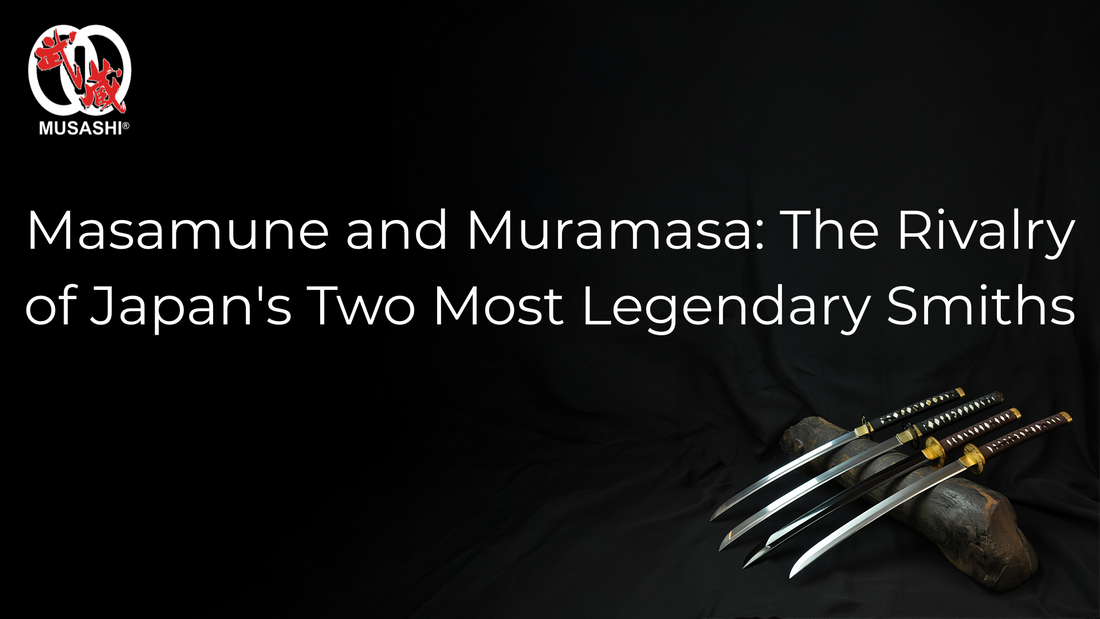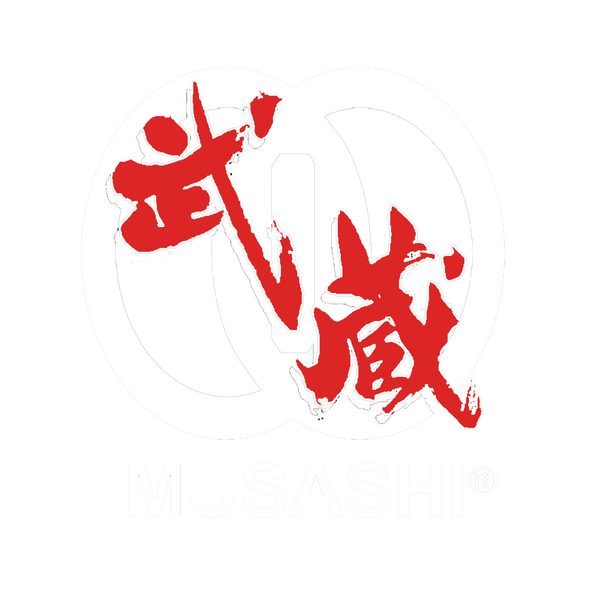
Masamune and Muramasa - Exploring the Rivalry of Japan's Most Legendary Swords
Masamune and Muramasa - The Rivalry of Japan's Two Most Legendary Smiths is a tale that highlights the contrast between good and evil through the legendary swords created by these famous Japanese sword makers. Their blades, including the feared Muramasa katana and revered Masamune sword, influenced samurai culture and the era of Tokugawa Ieyasu's shogunate with their powerful reputations.
Masamune - The Revered Swordsmith of the Kamakura Period
Early Life and Training
Masamune was a master swordsmith from the Kamakura period. He trained hard under skilled mentors. This early apprenticeship taught him traditional forging techniques. It shaped his respect for swordmaking as an art.
Key Characteristics of Masamune's Blades
Masamune blades show exquisite beauty and supreme excellence. Each sword is hand-forged with high-quality steel. They have a strong, sharp edge that lasts long. The hamon patterns on the blades are wavy lines made during quenching. These patterns add both style and quality marks. Collectors still admire these timeless swords today.
Famous Masamune Swords and Their History
The Hojo Masamune sword stands out among his creations. This sword holds historical significance and is a national treasure. Samurai used it in important battles during Japan's feudal era. Such swords tell stories beyond being simple weapons.
The Muramasa Curse - Fact or Fiction?
Origins and Beliefs Surrounding the Curse
The story of the Muramasa curse mixes superstition, folklore, and political propaganda. People believed Muramasa swords held an evil spirit. These bloodthirsty swords seemed to push their owners toward violence and bad luck. Some thought the blades caused madness or made minds unstable.
Rival groups during Japan's feudal times probably spread these stories. They wanted to make Muramasa swords look cursed to weaken their enemies. Folklore added to this by painting the blades as evil forces. This is different from the Masamune smiths, whose swords symbolized honor and balance.
So, the origins of the Muramasa curse come from both real fear about violent power and intentional rumors inside samurai society.
Instances of Misfortune Linked to Muramasa Swords
Many tales link bad luck to owners of Muramasa swords. These stories often involve warriors with violent tempers who used these blades during
Comparing the Artistry of Masamune and Muramasa
The story of Masamune and Muramasa is a famous one in Japanese swordsmith history. Both were skilled swordsmiths who made legendary Japanese swords. Their blades show very different ideas and styles. These swords hold deep samurai heritage and still get respect today. They show what traditional Japanese swords really mean – a legacy echoed in our range of traditional Musha katana swords that celebrate centuries-old craftsmanship and samurai heritage.
Distinitive Blade Characteristics
Masamune and Muramasa used different materials and forging techniques from Japanese metallurgy. They worked with hand-forged steel, folding the metal many times to make it strong and remove bad parts. This gave them high-quality steel needed for good blades.
Here's how their blades differ:
-
Masamune's blades:
- Katana with smooth, balanced curves
- Tachi with long, elegant shapes for fighting on horseback
- Wakizashi and tanto with neat, balanced sizes
-
Muramasa's blades:
- Katana with sharper angles
- Thicker and more powerful profiles
- Designs that look wild and aggressive
Both used the hamon well. The hamon is the temper line on the blade edge that shows expert forging skill.
The Hamon - A Hallmark of Mastery
Hamon patterns are more than just pretty lines on a sword. They show how well the blade was heated and cooled during forging. This affects how strong or sharp the sword is.
Masamune's hamon often looks like gunome-midare, which means gentle waves along the edge. You can see tiny nie crystals that sparkle. This makes a nice misty glow called the nioi effect. It shows great skill and balance. Muramasa's hamon looks bolder and less regular. The lines are rougher, matching his blades' fierce nature. His katana are known as some of Japan's sharpest. The strong temper lines fit his style of power over polish. Making these hamon requires skill in temperature control during each step of forging. Swordsmiths must be exact to get sharp edges that last in battle.
Stylistic Differences and Innovations
Masamune's style focuses on elegance and fine details. His swords have smooth curves, good balance, and clean finishes. They follow old traditions passed down by many craftsmen.
Muramasa's swords look tougher and sharper. They feel aggressive—some call them "bloodthirsty" katanas because they cut so well in fights. His style added bold changes while still using traditional sword smithing techniques.
Together, Masamune and Muramasa show how Japanese swordmaking moved from pure beauty to adding fierce strength without losing craft quality.
The Cultural Impact of Masamune and Muramasa Swords
Masamune and Muramura are two famous names in Japanese swordsmith tradition. Their swords show great skill and also carry deep meaning in samurai heritage. These blades shaped how samurai fought and influenced Japanese culture, especially during the Tokugawa shogunate.
People respect these legendary Japanese swords for their quality and history. They are a big part of samurai culture and the stories passed down about warriors.
Influence on Samurai Culture and the Tokugawa Shogunate
Masamune and Muramura swords were more than just weapons. They stood for samurai honor and status. Warriors wanted to own these blades because they showed prestige.
Here's what made these swords special:
- Sharpness that could cut through tough targets
- Strength to last in battle
- Balance for quick, smooth moves
- Made with traditional forging techniques, folding steel many times
During the Tokugawa shogunate (1603–1868), Japan saw less war. So, these swords became symbols of social rank more than tools of war. Samurai prized the beautiful curves and strong steel made by skilled swordsmiths.
This time also created a famous rivalry: Masamune's blades were known for elegance and lasting power. Muramura's blades had a fierce sharpness but were thought to be cursed. This rivalry caused both respect and fear among warriors.
The swords reflected values like discipline, loyalty, and legacy that defined samurai life. The Tokugawa laws also controlled weapon use, making these swords rare treasures in historical Japanese weaponry.
The Enduring Fascination with Legendary Swords
Masamune's blades stay famous for beauty and history. Collectors want real ones because they show centuries of skill. These swords are valuable items kept safe by experts.
Muramura swords attract attention too because of their spooky legends. People say they have strange powers that made them feared but respected long ago.
Both types of swords tell stories beyond fighting tools:
- They show deep traditions in craftsmanship
- They connect people to samurai heritage
- They inspire thoughts about myth vs reality
Collecting and Appreciating Masamune and Muramasa Swords
Masamune and Muramasa swords are some of the most wanted treasures in Japanese sword collecting. People prize these blades for their amazing craftsmanship and deep ties to samurai history; explore our collection of authentic Japanese katanas to discover similar treasures. Owning an authentic katana made by these smiths connects collectors to Japan's past.
The samurai sword collecting community highly values these swords because they're rare and hold strong cultural meaning. They often grab lots of attention at Japanese sword auctions around the world. Whether you're a seasoned collector or just starting out, knowing the story behind Masamune and Muramasa blades adds meaning beyond just owning them.
Authenticating and Verifying Sword Provenance
To authenticate a Masamune or Muramasa sword, you must check its provenance carefully. Expert examination helps confirm authentic craftsmanship by looking closely at blade signatures (mei) left by the smiths. The Nihon Bijutsu Token Hozon Kyokai (NBTHK) is Japan's top group for certifying real samurai swords.
Sword appraisal looks at things like hand-forged steel quality, blade shape, temper lines called hamon, and how well it's preserved. Provenance papers also help prove authenticity by showing who owned it before, especially if those owners are known or listed in records.
The Importance of Expert Examination
Expert examination keeps samurai heritage safe and protects buyers' investments. Skilled appraisers know how to spot details regular folks miss—like marks under rust or tiny grain structures inside the steel.
This close look makes sure each piece is true to history while guarding against fake swords, which are common when it comes to famous makers like Masamune and Muramasa.
Preserving the Traditions of Japanese Swordsmithing
Masamune and Muramasa stand out as top figures in Japanese craftsmanship. They used hand-forged steel and kept swordsmith tradition alive for centuries. Their sword forging process involved folding and tempering steel many times. This made the blades strong and gave them unique patterns called hada. Such authentic craftsmanship made each sword more than just a weapon.
Traditional Japanese swords made by these craftsmen show great blade craftsmanship. The process started with choosing high-quality tamahagane steel. Then, careful quenching and shaping gave each blade its form. These steps show respect for both function and beauty. Their swords still symbolize honor and skill in samurai heritage today.
Some key points about their work include:
- Use of tamahagane, a special type of steel
- Folding steel to improve strength
- Creating distinct patterns on blades (hada)
- Balancing sharpness with durability
- Making swords that are both tools and art
This careful work kept ancient techniques alive and passed down through generations.
The Continued Reverence for These Master Craftsmen
People still revere Masamune and Muramasa for their legendary Japanese swords. Collectors, historians, and martial artists admire these blades for their exquisite beauty and strength. They have earned a legendary status that lasts across time.
These master swordsmiths showed more than skill. Their work represents the spirit of samurai honor and tradition. Their swords are valued not only for fighting but also as cultural treasures. Museums worldwide display these creations to honor the rich history behind them.
Here's why they remain so important:
- Their swords combine beauty with durability
- They symbolize samurai honor and values
- Their work reflects deep cultural history
- Museums preserve their blades as art pieces
Their legacy goes beyond metalwork—it connects to identity and respect.
Exploring the Myths and Realities of Their Rivalry
The rivalry between Masamune and Muramasa is famous in Japan but mixed with myth. Both worked around the same time, yet much about their story is unclear or exaggerated. Separating fact from fiction shows very different legacies shaped by culture, not direct competition.
Muramasa's swords got a bad reputation from stories about a "Muramasa curse." People said his blades brought bad luck or bloodlust to owners. On the other hand, Masamune's blades are linked to peace and spiritual balance in samurai tales. These myths shaped how people saw each smith but don't tell the whole truth.
To understand this better:
- Look at real history alongside folklore
- Know that legends don't explain everything
- Respect both smiths for their skills equally
- Remember myths add drama but not facts
Both Masamune and Muramasa left strong marks on Japanese swordmaking, even if their stories got tangled over time.
FAQs
What role did sword testing play in their legacy?
Sword testing proved the razor-sharp edges and superior craftsmanship of both smiths. This reinforced their iconic status in samurai warfare and sword dueling.
Why are Masamune swords considered timeless and revered?
They embody artistic perfection with exquisite sharpness and balance. Their sacred nature and profound beauty connect deeply to samurai honor.
What causes the perception of Muramasa swords as cursed or demonic?
Folklore ties them to unstable minds, violent tempers, and madness. The "Muramasa curse" highlights a malevolent spirit thought to provoke bloodlust.
How does the sword forging process differ between these masters?
Both used hand-forged, folded steel but varied in blade tempering. Masamune's work shows clean, smooth hamon lines. Muramasa's blades have bold, rough temper lines matching their fierce style.
Are these swords sought after as collector's items today?
Yes, authentic Masamune and Muramasa blades are rare treasures highly valued in Japanese sword auctions worldwide.


